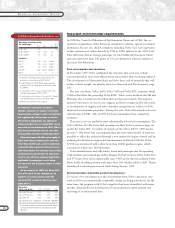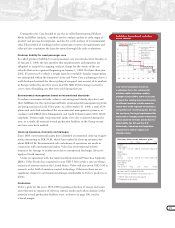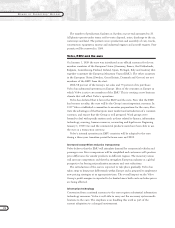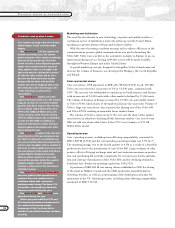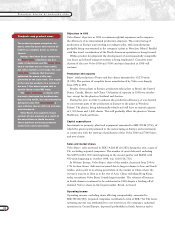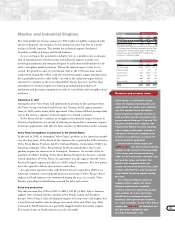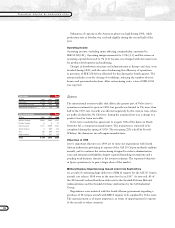Volvo 1998 Annual Report Download - page 32
Download and view the complete annual report
Please find page 32 of the 1998 Volvo annual report below. You can navigate through the pages in the report by either clicking on the pages listed below, or by using the keyword search tool below to find specific information within the annual report.
30
FINANCIAL REVIEW BY BUSINESS AREA
Number of trucks produced 1994 1995 1996 1997 1998
Volvo FLC and FL6-series 7,150 7,330 7,660 8,670 8,780
Volvo FL7, 10, and 12-series
and FM7,10, and 12-series 7,700 9,760 9,810 8,940 9,350
Volvo FH-series 20,250 25,740 24,200 23,180 30,610
Volvo NL and NH-series 7,600 7,330 4,670 6,440 5,490
Volvo VN Series 126,490 27,250 16,410 22,490 30,540
Total 69,190 77,410 62,750 69,720 84,770
1 Also includes other truck models produced in the United States
Volvo Trucks also concluded an agreement with Meritor Inc, an American
company, covering the global supply of axles. This involves lower costs for
Volvo, as a result of Meritor’s advantages of scale as a worldwide manufacturer.
The agreement also includes Meritor taking over Volvo Trucks’ production of
axles in Lindesberg, Sweden.
Production and capacity
The utilization of capacity in Volvo Trucks’ industrial system was high during
1998. However, the rate of production in the assembly plant in Curitiba, Brazil
was reduced in the fourth quarter to adapt to declining order bookings in the South
American market. A total of 84,770 trucks (69,720) were produced in 1998.
In 1998, within the framework of its strategy of a strengthened presence in
certain developing markets, Volvo Trucks began to assemble heavy trucks in
Bangalore, India. During the year a letter of intent was signed with the city of
Moscow covering an agreement to explore the possibilities of forming a joint-
venture company to produce Volvo trucks for the Russian market. The project
with China National Heavy Truck Corporation pertaining to joint development
and production of trucks for the Chinese market is proceeding and production is
scheduled to start during the latter part of 1999.
Capital expenditures
Trucks invested SEK 2,612 M (2,439) in property, plant and equipment
in 1998. A cab production facility was placed in service in the Curitiba plant,
Brazil. Measures to increase capacity and improve the environment were imple-
mented in the engine plant in Skövde, Sweden, and the cab finishing plant in
New River Valley in the US. The investments also included equipment and tools
used to produce the FM family of trucks, as well as marketing investments
pertaining to sales, service and workshops in Central and Eastern Europe.
Sales and market shares
Volvo Trucks delivered 83,280 medium-heavy and heavy trucks in 1998, an
increase of 21% compared with 1997 deliveries. The increase was attributable
to a continuing strong total market combined with an attractive product range.
In Western Europe, 37,810 vehicles (31,040) were delivered and Volvo’s share
of the market for trucks in the heavy class amounted to 15.2% (15.3).
In 1998, Volvo Truck’s deliveries in North America amounted to 29,310 units
(20,900), 40% more than in the preceding year partly due to Volvo VN’s good
market acceptance. The company’s share of the market for heavy trucks (Class
8) in the US rose to 11.5% (9.7) on an increasing total market.
Deliveries in the Brazilian market decreased to 4,090 trucks (4,510) and
Volvo’s share of the market amounted to 23.1% (23.3).
More than 90% of Trucks’ production
consists of trucks in the heavy class, more
than 16 tons total weight. In this class in
1998 the company launched the Volvo
FM, which has been developed specifically
for regional and construction-project
transports. The FM series has involved
development costs and investments
amounting to SEK 200 M each. The focus
in connection with development of the
Volvo FM was on quality, fuel economy
and operator-comfort.
A new generation of the FH series,
which was launched in 1993 and of which
more than 130,000 units have been sold,
was also presented during 1998. Trucks in
the new FH series have new engines and
gearboxes as well as a new electronics
system that reduces maintenance require-
ments.
Other models in the heavy class within
the framework of the global modular
concept comprise the Volvo VN and Volvo
VN 770, of which 50,000 units, since the
introduction in autumn 1996 and 1997,
have been sold in the North American
market, plus the Volvo NH in Australia.
In the medium-heavy class (7,5 to 16
tons total weight), Volvo markets the FLC
and FL6 models which are designed for
city distribution systems, mainly in
European markets.
Cooperation with Mitsubishi comprises
distribution of the Mitsubishi Canter light
truck in Great Britain, France and Italy.
Products and products news


